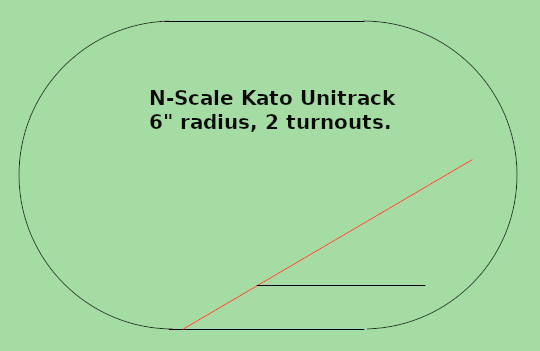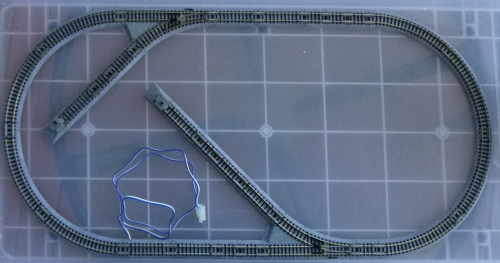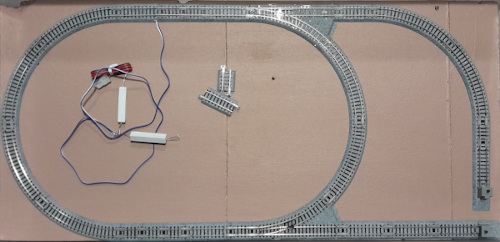A Japanese themed micro / ultra-micro layout approximately 2×1 feet in size.
I have only ever had one N scale layout in my life before building this layout, and at the time I had that previous N scale layout I opted to return to HO scale due to the size of the trains. And I’ve been reluctant to try N scale (or even HOn / HOe) ever since, due to the cost of starting to model in a scale which would require me to buy new trains and track. But in late April / early May 2023, I watched a number of videos produced by Budget Model Railway on YouTube about Kato’s Pocket Line N scale train packs and Kato Unitrack that have made me re-think about N scale.

Kato’s Pocket Line series are very inexpensive. I had heard very good reviews about them, and some eyars ago I had a Kato HO scale locomotive, which I found to be very reliable. So in May 2023, I purchased a Kato Pocket Line train pack, comprising a small steeple cab electric locomotive and 2 freight cars with the idea of doing a micro, or ultra-micro, layout in N scale as an experiment. I also purchased enough track to make an oval of track and a few spurs.
Evolution of a Track Arrangement
The initially proposed track plan was something like this.

The original plan was for it to feature a freight loading area, a loop of track, some mountain scenery, and something other than the trains that would identify it as a Japanese themed layout housed in a small (possibly custom built) wooden container. Pretty quickly the idea of having the layout in a wooden container was scrapped in favour of housing it in a standard size plastic storage box. The original plan included the possibility of adding a 2 car Pocket Line tram, which at the time I purchased it was a little less expensive than the 3 vehicle train pack and can easily negotiate the 6″ radius curves, and the inclusion of a tram stop or small passenger station on the layout.
Over time, I made a baseboard, purchased and set up the track in a number of configurations. The first track plan I thought of trying was the one below.

This worked ok when the train was going around the oval of track, both pulling and pushing a train, but the light carriages didn’t like being pushed into the spurs. So I tried another track arrangement, significantly different, with the spurs on the outside of the oval of track, like this.

The two spurs are the freight spurs. This track arrangement worked well with trains being pushed into the spurs as well as pulled out of them, a much more satisfactory set up. Another thing I did, which is clearly seen in the above track arrangement photo, was put two 10 watt 470 ohm resistors in the circuit to slow the train down. In the process of testing various track arrangements I realised that the turnouts were self isolating which means if the point blades are set against a section of track that section is isolated from the power supply, just like the Peco Insulfrog range – an added bonus.
Around the time I purchased the 2 car Pocket Line tram for the layout, I decided that it would be best to have two or maybe even three tram stops – one or two in two of the spurs , and one between the two freight spurs on the oval of track. This would allow the possibility of the tram going between two different locations on the layout rather than just around and around and then stopping at the single tram stop. This meant the purchase of another turnout and buffer stops so an extra spur could be added. I also changed the arrangement of the two spurs on the outside of the oval as I felt that this would be better for operations. At that point in the experiment, the track arrangement looked like this.

Operations
Operating this layout includes passenger tram and electric train freight operations.
The passenger service is based on the premise that the tram runs a shuttle service between the tram terminus (the section of oval between the two spurs that are outside the oval) and a tram stop at the spur inside the loop, and between the tram terminus and a tram stop at the long curved spur in the bottom right hand corner.
The spur at the bottom right hand corner is also a freight track. The spur in the top right hand corner is another freight spur. The tram stop at the spur inside the oval can also handle some freight.
Freight operations involve moving freight cars between the transhipment track, the freight spur, and the tram stop inside the oval, as required.
Industries
Industries served include:
- Freight marine – rail transhipment.
- A consumer electronics supplier.
- A Japanese foods wholesaler.
- Retail businesses.
- Lumber and timber production.
Track
The track I purchased for use on this layout are as follows:
- 1 pack x Kato Unitrack 20-040: Straight track 2 7/16″ / 62mm (4 pieces in a pack).
- 2 pack x Kato Unitrack 20-046: Straight track with bumper A 2 7/16″ / 62mm (2 pieces in a pack).
- 1 pack x Kato Unitrack 20-041: Feeder track 2 7/16″ / 62mm (1 piece in a pack + connecting wire).
- 1 pack x Kato Unitrack 20-091: Track assortment set, 1 1/8″ / 29mm, 1 3/4″ / 45mm set.
- 2 pack x Kato Unitrack Compact 20-174: Curved track R150mm / 6″ (4 pieces in a pack).
- 2 x Kato Unitrack Compact 20-240: Electric left hand turnout 150mm / 6″.
- 1 x Kato Unitrack Compact 20-241: Electric right hand turnout 150mm / 6″.
Most of the pieces of track were used in the final track arrangement.